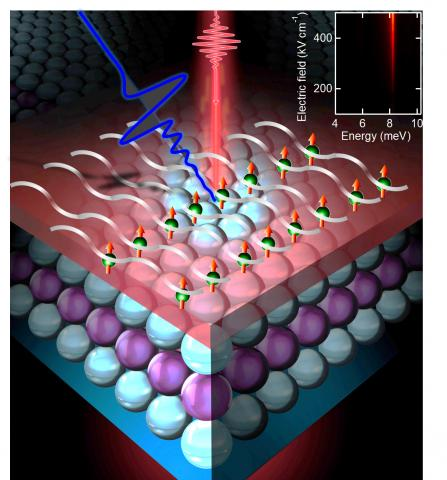Feb 19 2020
At the Ames Laboratory of the U.S. Department of Energy, researchers have found that the key to avoiding dissipations of the preferred electron states, which would render spintronics and advanced quantum computing possible, could be to apply vibrational motion in a periodic way.
 Ames Laboratory scientists took a paradoxical approach, called dynamic stabilization, by applying a terahertz electric field to drive periodic lattice oscillations in a model topological insulator. These additional fluctuations actually enhanced protected topological states. Image Credit: Ames Laboratory.
Ames Laboratory scientists took a paradoxical approach, called dynamic stabilization, by applying a terahertz electric field to drive periodic lattice oscillations in a model topological insulator. These additional fluctuations actually enhanced protected topological states. Image Credit: Ames Laboratory.
In their bulk form, certain topological materials act as insulators. However, they exhibit electron-conducting behavior along their surfaces. Although the difference in the surface electron behavior is what renders these materials potential candidates for technological applications, it also poses a difficulty.
Unregulated interactions between the bulk material states and the surface electrons can lead to scattering of electrons out of order, which results in what is called “topological breakdown.” They are not safeguarded by “spontaneous” symmetry of any form.
Topological insulators that can sustain a persistent spin-locked current on their surfaces which does not decay are termed ‘symmetry protected,’ and that state is compelling for multiple revolutionary device concepts in quantum computing and spintronics. But the topological breakdown due to surface-bulk coupling is a long standing scientific and engineering problem.
Jigang Wang, Physicist, Ames Laboratory
Wang, who is also a professor at Iowa State University, and his colleagues resorted to a paradoxical approach, named dynamic stabilization, which involves applying a terahertz electric field to induce periodic atomic vibrations (or vibrational coherence) in the model topological insulator bismuth-selenium, Bi2Se3.
These additional “fluctuations” actually improved the protected topological states, thereby extending the life of the electronic excitations.
A similarity of such dynamic stabilization is the periodically induced Kapitza pendulum, named after Nobel Laureate Peter Kapitza. In this case, an inverted, but stable, orientation is realized by inducing an adequately high-frequency vibration of its pivot point. In the same way, further dynamic stabilization can be realized by inducing quantum periodic motions of the lattice.
We demonstrate the dynamic stabilization in topological matter as a new universal tuning knob, that can be used to reinforce protected quantum transport.
Jigang Wang, Physicist, Ames Laboratory
According to Wang, the findings of this study could have far-reaching implications for using these materials in various scientific and technological disciplines, like spin-based, lightwave quantum electronics and disorder-tolerant quantum information and communications applications.
The study has been described in detail in a paper titled “Light Control of Surface-Bulk Coupling by Terahertz Vibrational Coherence in a Topological Insulator,” penned by X. Yang, L. Luo., C. Vaswani, X. Zhao, D. Cheng, Z. Liu, R. H. J. Kim, X. Liu, M. Dobrowolska, J. K. Furdyna, I. E. Perakis, C-Z Wang, K-M Ho, and J. Wang. The paper has been published in npj Quantum Materials.
The samples were developed at the University of Notre Dame. A part of the analysis and calculations were conducted at the University of Alabama, Birmingham.